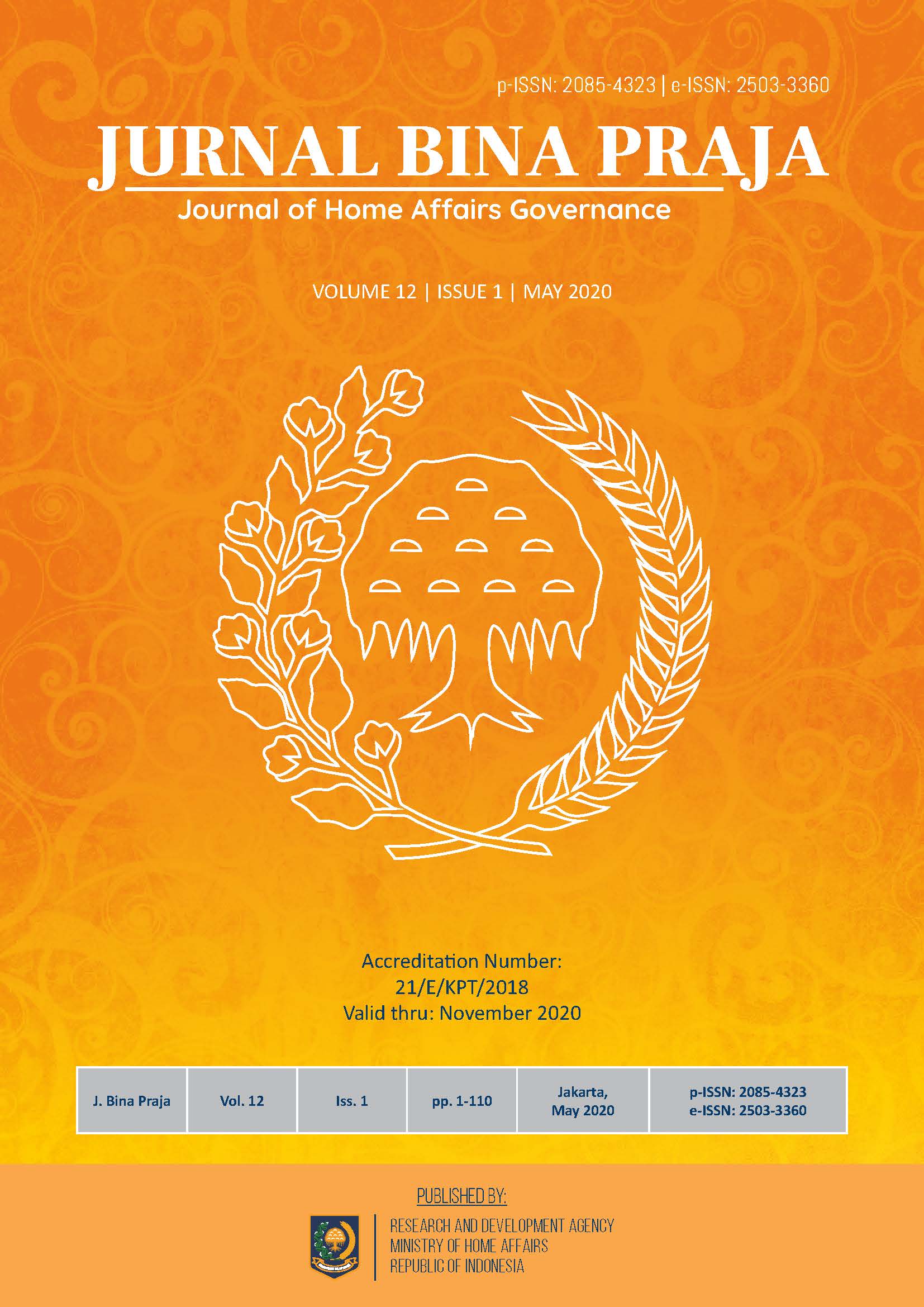Performance Analysis of Depok City Health Office in Supporting Child-Friendly City
DOI:
https://doi.org/10.21787/jbp.12.2020.1-10Keywords:
Child-Friendly City, Health Office, Depok City, Children's Nutritional Status, 7s ModelAbstract
Government has to pay attention to the fulfillment of children's rights because later they will determine the fate of the nation and state in the future. One of the things that can be done by the Government is by organizing a Child-Friendly City. One significant cluster related to the implementation of a Child-Friendly City is a cluster of essential health and well- being. The Depok City Government through the Health Office has made various efforts to support the realization of a Child-Friendly City in the health sector. The research method used in this study is qualitative with a post-positivist approach. Based on the results of the study, through the target approach in measuring organizational effectiveness by S. B Lubis and Martani Huseini, the Health Office has exceeded the goals set out in the Medium Term Development Plan. The achievement of these targets is inseparable from the factors that influence the organization in carrying out its performance. Based on McKinsey's theory, seven factors influence the Health Office to support Child-Friendly Cities, two of which have gone well, namely, the leader who motivate their subordinates and the budget and technology that supports the implementation of Child-Friendly Cities. But the other five factors have not gone well, namely the Health Office does not yet have a specific strategy related to Child-Friendly Cities, coordination that has not run optimally, lack of Human Resources both in terms of numbers and competencies and the absence of organizational culture specifically for the Office of Health in carrying out its functions. Therefore, the Health Office needs to make improvements from the factors that have not gone well so that Depok City can be a Child- Friendly City.
Keywords: Child-Friendly City, Health Office, Depok City, Children's nutritional status, 7s Model
Downloads
References
Bishop, K., & Corkery, L. (2017). Designing Cities with Children and Young People. In K. Bishop & L. Corkery (Eds.), Designing Cities with Children and Young People: Beyond Playgrounds and Skate Parks. Routledge. https://doi.org/10.4324/9781315710044
Chan, L., Erlings, E., Mizunoya, S., & Zaw, H. (2016). A City Fit for Children: Mapping and Analysis of Child Friendly Cities Initiatives. Centre for Rights and Justice Occasional Paper Series.
Creswell, J. W. (2008). Research Design: Pendekatan Metode Kualitatif, Kuantitatif, dan Mixed. Pustaka Pelajar.
Cushing, D. F. (2016). Youth Master Plans as Potential Roadmaps to Creating Child- and Youth-friendly Cities. Planning Practice and Research. https://doi.org/10.1080/02697459.2015.1110472
Dinas Kesehatan Kota Depok. (2017). Profil Kesehatan Kota Depok Tahun 2016. Dinas Kesehatan Kota Depok.
Dinas Kesehatan Kota Depok. (2018). Profil Kesehatan Kota Depok Tahun 2017. Dinas Kesehatan Kota Depok.
Febriyanti, A., & Juwono, V. (2017). The Acceleration of Food Consumption Diversity Policy Implementation through Sustainable Food-Reserved Gardening: The Case of Jakarta. Proceedings of the International Conference on Administrative Science, Policy and Governance Studies (ICAS-PGS 2017) and the International Conference on Business Administration and Policy (ICBAP 2017). https://doi.org/10.2991/icaspgs-icbap-17.2017.14
Frieden, T. R. (2013). Government’s Role in Protecting Health and Safety. New England Journal of Medicine, 368(20), 1857–1859. https://doi.org/10.1056/NEJMp1303819
Gill, T. (2019). Widening the bandwidth of child-friendly urban planning in cities. Cities & Health, 3(1–2), 59–67. https://doi.org/10.1080/23748834.2019.1660126
Goldfeld, S., Villanueva, K., Tanton, R., Katz, I., Brinkman, S., Giles-Corti, B., & Woolcock, G. (2019). Creating community indicators for early childhood development: challenges and innovations from the kids in communities study. Cities & Health, 3(1–2), 68–77. https://doi.org/10.1080/23748834.2019.1596525
Gowan, M., Seymour, J., Ibarreche, S., & Lackey, C. (2001). Service quality in a public agency: same expectations but different perceptions by employees, managers, and customers. Journal of Quality Management, 6(2), 275–291. https://doi.org/10.1016/S1084-8568(01)00040-2
Hadi, D. U., & Juwono, V. (2019). Implementation of a Collaborative Governance Model in Mass Rapid Transit Development in Jakarta. 33rd IBIMA Conference, 7696–7707. https://ibima.org/accepted-paper/implementation-of-a-collaborative-governance-model-in-mass-rapid-transit-development-in-jakarta/
Hasibuan, M. S. P. (2011). Manajemen Sumber Daya Manusia. Bumi Aksara.
Kementerian Kesehatan. (2018). Buku Saku Pemantauan Status Gizi Tahun 2017.
KPP&PA, & BPS. (2015). Profil Anak Indonesia 2015. KPP & PA.
Lubis, S. B. H., & Huseini, M. (2009). Teori Organisasi: Suatu Pendekatan Makro. Departemen Ilmu Administrasi FISIP UI.
McAllister, C. (2008). Child friendly cities and land use planning: Implications for children’s health. Environments, 35(3), 45–61. https://www.researchgate.net/publication/289351153_Child_friendly_cities_and_land_use_planning_Implications_for_children’s_health
Monaghan, J. (2019). Engagement of children in developing healthy and child-friendly places in Belfast. Cities & Health, 3(1–2), 29–39. https://doi.org/10.1080/23748834.2018.1527175
Nam, H., & Nam, S. I. (2018). Child-friendly city policies in the Republic of Korea. Children and Youth Services Review, 94, 545–556. https://doi.org/10.1016/j.childyouth.2018.08.033
Riggio, E. (2002). Child friendly cities: good governance in the best interests of the child. Environment and Urbanization, 14(2), 45–58. https://doi.org/10.1177/095624780201400204
Sedletzki, V. (2011). Child Rights and Governance Roundtable: Report and Conclusions. https://www.unicef-irc.org/publications/674-child-rights-and-governance-roundtable-report-and-conclusions.html
Singal, A. (2017). Aspek Hukum Peran Pemerintah Melindungi Hak Anak Dalam Memperoleh Pelayanan Kesehatan. Jurnal Hukum Unsrat, 23(9), 38–52. https://ejournal.unsrat.ac.id/index.php/jurnalhukumunsrat/article/view/16051
UNICEF. (2017). The State of the World’s Children 2017: Children in a Digital World. UNICEF. https://www.unicef.org/publications/index_101992.html
van Vliet, W., & Karsten, L. (2015). Child-Friendly Cities in a Globalizing World: Different Approaches and a Typology of Children’s Roles. Children, Youth and Environments, 25(2), 1. https://doi.org/10.7721/chilyoutenvi.25.2.0001
















